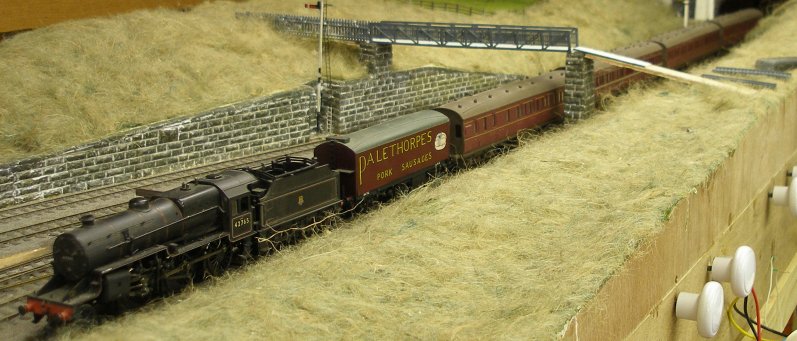
Palethorpe's Sausage Vans
In the December 1966 issue of the 'Railway Modeller' was an article - with plans - of the Palethorpe's 6-wheeled sausage van. So when one of the W&T kit built ones came up on eBay I bought it for its novelty value.

The 'Railway Modeller' article includes a plan of the six-wheeled van plus photographs of 38733 in LMS and M36732M in BR livery, but provides the scantiest of details of their routes, although the article notes that were subject to circuit working i.e. as one van was out-bound, its companion would be in-bound, so the two vans on a 'circuit' would presumably pass each other sometime during the day.
The Palethorpe's factory was in Tipton, but serviced by a siding at the factory accessed from Dudley Port station. Both the LMS and GWR were involved in building a fleet of vans for Palethorpe's. The liveries were similar, except that the two GW vans had a brown base colour, whilst the LMS van were maroon, but the lettering and decals were identical.
Hornby produced a China-made van in GWR-brown livery with monogram, and numbered 2802. The vans apparently made it into the late 1960s - see photo on Flickr of one at Woodham's scrap yard in May 1967, although without the pack of sausages! There were only two GWR vans - 2801 and 2802. The alternative Hornby reference number is R6158A. 'Back Track' magazine ( volume 20 no 7 July 2006 page 414) has a colour photo of one of these at Worcester, and appears to show the colour scheme, lettering and logo as per the Hornby model.
Issue 89 of 'Model Railway Journal' (1996) has an article by Tim Shackleton in which he describes the construction of a bogie van. Tim notes that twelve LMS vans were built of four different designs, but all finished in the same house style. The first to be delivered were four six-wheelers, 38732-5, and were similar to the contemporary Milk vans. Two four-wheelers, 38730-1 appeared to a one-off design. A photograph of one of these appears in 'An Illustrated History of LMS Coaches 1923-1957' by Bob Essery and David Jenkinson in plate 235. This shows van 38731 in LMS livery with one pair of double doors and rated at 3 tons. The book suggests that they were converted to 'Passenger Vans' in 1956. In style, they are similar to the six-wheel vans with flush plywood sides, three ice boxes on the roof, and a centre ladder and two platforms half way up one end for access to the roof and ice boxes. The other end was plain. There were two designs of 50 foot bogie vans; one having a corridor and appropriate connections.
Essery and Jenkinson give the withdrawal dates of the six-wheelers as between June - October 1966. The first bogie van to go was 38873 in March 1965, and 38874 to 38878 went between May and June 1967, although 38998 and 38999 were extant in 1969, although then classified as 'Insulated Cream Vans'. The two four-wheelers are shown withdrawn in October 1967.
Tim suggests that regular destinations were Bangor, Bradford, Bristol, Cardiff, Crewe, Edinburgh, Glasgow, Manchester, Newcastle and Stockport. Tim also notes that he regularly saw a bogie Palethorpe's van at the rear of a late-afternoon passenger working on the Bradford-Huddersfield route via the Calder Valley. He suspects this was a Stockport train conveying the empty Bradford van back to the Black Country via Crewe.
The RM article suggests GW Palethorpe's vans ran to Cardiff via Bristol. John Dunn in the October 2014 issue of 'Steam Days' provides a comprehensive history of the Palethorpe's traffic and the vans, and in the article John suggests that it was the GW van that was 'first away' each morning, being picked-up by the Dudley Port - Dudley auto-train.
The LMS vans apparently left as a train at 05.25 a.m. bound for Crewe. In 1936, according to John Dunn, the vans were split at Crewe with two going forward on the 07.30 a.m. to Carlisle, with the Heysham (for Ireland) coming off at Preston, and then going forward on the 9.0 a.m. to Heysham. The Manchester van went forward on the 09.45 to Manchester (London Road), whilst the Leeds and Newcastle vans were attached to the 12:20 to Newcastle. Perhaps slightly odd that the vans with the greatest distance to travel were the last to leave, or does this reflect a paucity of trains going east?
In 1940 Euston, Perth and Newcastle each received a bogie van; Cardiff, Carlisle and Manchester got a six-wheeler each. John reports that by 1961 only two vans were being used for Palethorpe's traffic with a six wheeled (38732) and a bogie van (38877) in a circuit to Perth, with the remaining vans parked up at Dudley. 38732 was latterly used for parcels from Wolverhampton Low Level.
As a general rule, the vans were attached to passenger trains immediately behind the locomotive. One of the photos accompanying John's article shows Stanier 4MT tank 42616 leaving the Up loop at Muspratt's sidings on a rake of mixed stock with a six-wheeled van at the head of the rake in August 1954 when shedded at Aston.
